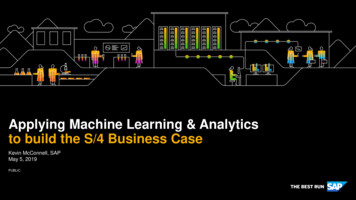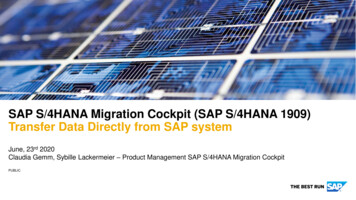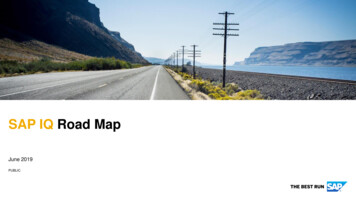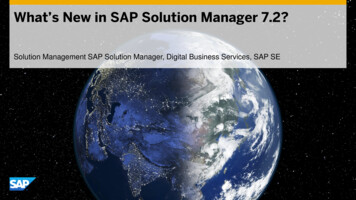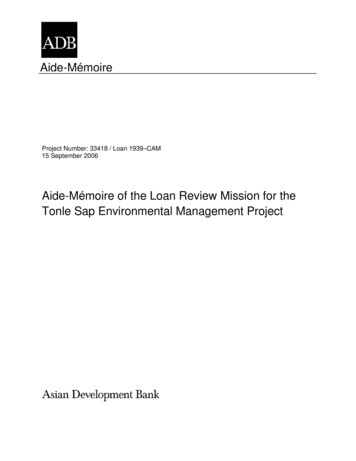
Transcription
Aide-MémoireProject Number: 33418 / Loan 1939–CAM15 September 2006Aide-Mémoire of the Loan Review Mission for theTonle Sap Environmental Management Project
CURRENCY EQUIVALENTS(as of 10 September 2006)Currency UnitKR1.00 1.00– riel (KR) ��–––UNDPUNESCOVSO–––Asian Development BankCommunity Fisheries Development OfficeCommunity Fisheries Development UnitsCambodia National Mekong CommitteeDepartment of FisheriesFood and Agriculture Organization of the United NationsGlobal Environment Facilitygeographic information systemsMinistry of Agriculture, Forestry, and FisheriesMinistry of Economy and FinanceMinistry of Environmentnongovernment organizationproject implementation officeproject implementation unitproject monitoring and coordination officeproject steering committeespecial drawing rightstechnical assistanceTonle Sap Biosphere ReserveTonle Sap Biosphere Reserve—Environmental InformationDatabaseUnited Nations Development ProgrammeUnited Nations Educational, Scientific, and Cultural OrganizationVoluntary Service OverseasNOTEIn this Report, " " refers to US dollars.
CONTENTSPageI.PREAMBLE1II.BACKGROUNDA.GeneralB.Key Facts on Loan Review Missions223III.STATUS OF PROJECT IMPLEMENTATIONA.Project Performance ReportB.Actions Taken on Issues Identified by the Last Loan Review MissionC.Status of Project ComponentsD.Allocation and Withdrawal of Loan ProceedsE.Contract Awards and DisbursementsF.Additional Input RequirementsG.Proposed Reallocation of Loan ProceedsH.Audit446123336373738IV.OTHER MATTERSA.Focusing on Project MetricsB.Voluntary Service Overseas383839V.SUMMARY OF FOLLOW-UP ACTIONS40VI.MILESTONES OF .4.5.DESIGN AND MONITORING FRAMEWORKINDICATIVE ACTIVITIES SCHEDULEPROJECT PERFORMANCE REPORTREVISED IMPLEMENTATION SCHEDULELIST OF PARTICIPANTS AT THE WRAP-UP MEETING4550536465
I.PREAMBLE1.Under the Tonle Sap Initiative, a partnership of organizations and people working tomeet the poverty and environment challenges of the Tonle Sap, the Asian Development Bank(ADB) is promoting an approach that conserves nature and offers the promise of sustainabledevelopment. Not everything can be tackled at the same time. For that reason, the Tonle SapInitiative uses geographical and temporal phasing of loan, grant, and technical assistance (TA)projects, working from the core areas of the lake to the watersheds over an 8-year period andrepeating this cycle as may be needed to build on accomplishments and embed lessons learnedfrom the first iteration. In 2003, the Tonle Sap Basin Strategy was drafted.1 It gave geographicalfocus to ADB's Country Strategy and Program, 2005–2009 and forms the basis for settingpriorities and planning assistance in the Tonle Sap basin in effective and efficient ways.2.At the center of the practical expression of the Tonle Sap Basin Strategy is theformulation and implementation of four major projects to address the concerns specific to eachzone. These four pillars buttress the implementation of the strategy, with each pillar joining thenext to support a cohesive long-term program. The Project is the first major project of the TonleSap Initiative. Converging on the core areas and the buffer zone of the biosphere reserve, ittackles the central issue of conservation in the Tonle Sap Biosphere Reserve (TSBR).Tonle Sap Initiative Website212ADB. 2005. The Tonle Sap Basin Strategy. Manila. The development objectives are to foster, promote, andfacilitate: (i) pro-poor, sustainable economic growth, (ii) access to assets, and (iii) management of naturalresources and the environment.Available: www.adb.org/projects/tonle sap/default.asp
2II.A.BACKGROUNDGeneral3.On 21 November 2002, ADB approved a loan in various currencies equivalent to 10.91million (or 12.16 million at current value) from ADB's Special Funds resources for the TonleSap Environmental Management Project.3 ADB also approved TA for 540,000 from ADB's TAfunding program for improving the regulatory and management framework for inland fisheries.4The Loan Agreement was signed on 7 February 2003, became effective on 27 March 2003, andcloses on 30 June 2008. The physical project completion date is 31 December 2007. As of 31July 2006, the period elapsed under the loan was 66%, ADB had committed 7.68 million (63%of the loan's current value), and ADB had disbursed 5.78 million (48% of the loan's currentvalue). The loan review mission of May 2006 estimated implementation progress at 55%.4.In ADB, the Project is classified as a "poverty intervention" with a thematic classificationof "environmental sustainability". The goal of the Project is sustainable management andconservation of natural resources and biodiversity in the Tonle Sap basin.5 Its objective is toenhance systems and develop the capacity for natural resource management coordination andplanning, community-based natural resource management, and biodiversity conservation in theTSBR (Appendix 1). Project implementation will span five years (Appendix 2).5.The design and monitoring framework anticipates that accomplishment of threecomponents and their related outputs and activities will enable the Project to achieve itsobjective:6 Component 1: Strengthening Natural Resource Management Coordinationand Planning for the TSBR. The monitorable outputs of component 1 are: (i)establishing a coordination framework and information disseminationmechanism; (ii) mapping the TSBR; and (iii) improving regulation andmanagement planning. Component 2: Organizing Communities for Natural Resource Managementin the TSBR. The monitorable outputs of component 2 are: (i) formulating animplementation structure; (ii) empowering communities; and (iii) evaluatingtechnical packages in support of sustainable livelihoods.3456At appraisal, the total project cost, including contingencies, taxes, and duties, was estimated at 19.36 millionequivalent, consisting of foreign exchange of 8.77 million (about 45%) and local currency of 10.59 millionequivalent (about 55%). The Global Environment Facility (GEF) determined to cofinance the Project for 3.24million through a grant to be implemented by the United Nations Development Programme (UNDP). GEF financingfor the Tonle Sap Conservation Project covers the near entirety of component 3. Details are provided in the GEFProject Brief. In addition, UNDP's Capacity 21 program determined to provide 627,030 as a grant to strengthenthe ability of members of staff of the Community Fisheries Development Office (CFDO) within the Department ofFisheries (DOF) to engage communities in natural resource management. Lastly, the Wildlife Conservation Societydetermined to cofinance, for 200,000, project activities to develop systems for monitoring and management in thecore areas.ADB. 2002. Improving the Regulatory and Management Framework for Inland Fisheries. TA 3993–CAM.The project area encompasses the TSBR and parts of its five adjoining provinces. It comprises the core areas, thebuffer zone, and the transition area that extends to and is ultimately bounded by Highways No. 5 and No. 6. About2.9 million people live in the project area, of whom about 38% are below the poverty line. About 10% dependwholly on fishing and about 40% have fishing as a secondary occupation. (Figures are from the population censusof 1998.)The design of the Project also envisaged direct selection of agencies such as the Food and AgricultureOrganization (FAO) of the United Nations and the United Nations Educational, Scientific, and Cultural Organization(UNESCO), which were reckoned to have particular related expertise.
3 Component 3: Building Management Capacity for BiodiversityConservation in the TSBR. The monitorable outputs of component 3 are: (i)enhancing management capacity; (ii) developing systems for monitoring andmanagement; and (iii) promoting biodiversity conservation awareness, education,and outreach.6.The Ministry of Agriculture, Forestry, and Fisheries (MAFF) is the executing agency forthe Project. DOF, in MAFF, is tasked with implementing the bulk of project activities that relateto strengthening natural resource management coordination and planning for the TSBR andorganizing communities for natural resource management in the TSBR. The Ministry ofEnvironment (MOE) is tasked with implementing the project activities that relate to buildingmanagement capacity for biodiversity conservation in the TSBR. The Cambodia NationalMekong Committee (CNMC) is tasked mainly with monitoring and coordinatingaccomplishments and formulating common policy objectives for managing the TSBR throughthe TSBR Secretariat. UNDP's Country Office in Phnom Penh is tasked with implementing theGEF and Capacity 21 program grants under the national execution modality. Voluntary ServiceOverseas (VSO) has built capacity to support implementation of components 1 and 2 based onarrangements deemed, subsequent to appraisal, to be of interest.B.Key Facts on Loan Review Missions7.ADB has dispatched loan review missions every six months. So far, these as well asdaily project administration work from ADB's headquarters have served well to assessdevelopments in project implementation, take necessary actions, and promote project quality.ADB also receives quarterly progress reports from the project monitoring and coordination office(PMCO), which oversees the work of the project implementation offices (PIOs) and the projectimplementation units (PIUs), as well as monthly progress notes from the internationalconsultants engaged under the Project. In addition, the project steering committee (PSC) hasmet regularly to advise on implementation, provide a mechanism to resolve problems that gobeyond single ministerial mandates, and review progress.8.ADB's first loan review mission was in Cambodia from 5–7 May 2003, soon after loaneffectiveness.7 It prepared a detailed project administration memorandum to guide Projectimplementation. It also explained to the executing and implementing agencies ADB's guidelinesand procedures on project implementation, consulting services, procurement, bid evaluation,and disbursement. In conformity with ADB's undertaking to carry out semiannual loan reviews,ADB's second loan review mission of ADB was fielded in 10–12 November 2003 to conduct adetailed review of overall progress under the Project.8 That mission appraised the status ofproject components, analyzed output accomplishment, and formulated measures to improveactivities. ADB's third loan review mission visited Cambodia from 14–18 June 2004. It alsomeasured progress against the same project performance monitoring and evaluationframework, paying particular attention to continuing impediments to engagement of key serviceproviders.9 ADB's fourth loan review mission assessed developments from 6–15 December2004. It took action to address red tape in MAFF and MEF and, in the face of persistent lack ofprogress, recommended that CNMC and MOE should rescind the two proposals for directselection of UNESCO and seek elsewhere the services required.10 ADB's fifth loan review7Reference is invited to its aide-mémoire, dated 7 May 2003.Reference is invited to its aide-mémoire, dated 14 November 2003.9Reference is invited to its aide-mémoire, dated 18 June 2004.10Reference is invited to its aide-mémoire, dated 15 December 2004.8
4mission conducted a midterm review from 14–28 October 2005.11 The mission overlaid theregular review process but also reviewed holistically the institutional, administrative,organizational, technical, environmental, social, economic, and financial aspects of the Project.ADB's sixth loan review mission, which visited Cambodia from 24 April to 3 May 2006, placedan even stronger accent on the sum of the Project's component parts and evaluated in detail theperformance of FAO's team.129.ADB's seventh loan review mission was conducted from 13–15 September 2006.13 Itkicked off by meeting project personnel at the PMCO on 13 September 2006. This aidemémoire records its findings and recommendations, which are subject to review and approvalby higher authorities of the Government and ADB.14 The format of the aide-mémoire departsfrom that of previous loan review exercises because of the need to concentrate on reallocationof loan proceeds. For details of the parameters commonly examined by loan review missions,reference is invited to the previous aide-mémoire and to the second quarterly report for 2006prepared by the PMCO. Its assessments remain valid, unless indicated otherwise below. Theprincipal function of the Mission was to work out, in consultation with CNMC, DOF, MEF, andMOE what reallocation of loan proceeds would best serve the Project's objective and whatfurther supportive adjustments were called for.III.A.STATUS OF PROJECT IMPLEMENTATIONProject Performance Report10.ADB operates a project performance rating system to establish the implementation (oroperational status) of each project and to identify projects that are encountering or couldencounter problems. This ulterior intention is to make out what remedial measures can be takenpromptly by the borrower, executing agency, implementing agencies, ADB, and as the casemay be, associated partners. Specifically, ADB's project performance rating system usesperformance indicators that assess both the implementation progress and the achievement ofthe (development) objective (or outcome). The rating on implementation progress applies tophysical and financial factors. The rating on achievement of the objective relates to thelikelihood that a project has of contributing to its goal (or impact). Given the cause-and-effectrelationship inherent to a project's design, satisfactory implementation is normally essential toachieving the objective. ADB's project performance rating system introduces a rating scale of:"highly satisfactory",15 "satisfactory",16 "partly satisfactory",17 "unsatisfactory",18 and "at risk".Projects are initially rated as satisfactory after approval by the Board of Directors of ADB andthe ratings are then updated periodically.11.A project's objective is a statement of the outcome expected from implementing itscomponents and accomplishing its outputs. Any significant success or deficiency encountered inproject implementation is likely to be reflected in the degree of achievement of a project's11Reference is invited to its aide-mémoire, dated 26 October 2005.Reference is invited to its aide-mémoire, dated 5 May 2006.13The Mission comprised O. Serrat (Mission Leader) and C. Garcia, Project Administration Officer. R. Fenn, DeputyTonle Sap Initiative Coordinator, helped the Mission to foster synergies with other operating outputs of the TonleSap Initiative and facilitated logistics.14The drafting of this aide-mémoire was facilitated by the progress report for the period April–June 2006 prepared bythe PMCO.15The project is expected to exceed most of its objectives (where there are several).16The project is expected to achieve most of its objectives (where there are several).17The project is expected to achieve some of its objectives (where there are several).18The project is unlikely to achieve its objectives (where there are several).12
5objective.19 The criteria referred to when assessing the rating on achievement of the objectiveare project-specific but commonly hark to: key policy assumptions (policy-based covenants suchas cost recovery and tariffs, financial performance of the executing agency, etc.); assumptionson environmental sustainability; assumptions on beneficiary participation and stakeholderownership; assumptions on economic and financial viability and cost recovery (e.g., costs andprices remain within the viable range identified during the appraisal sensitivity analysis);assumptions on institutional capacity, budget availability, and operation and maintenance;socioeconomic impact; political stability (peace and security); and baseline data availability andmonitoring mechanisms to measure development impacts. At present, the rating for the Projectwith regard to its objective is deemed to be "satisfactory".12.The criteria referred to when assessing the rating on implementation progress hark to:timely project implementation; changes in project scope; changes in implementationarrangements; project cost overrun; provision of counterpart funds and cofinancing; compliancewith major covenants; and submission of audited project accounts and agency financialstatements. At present, the project performance rating with regard to implementation progress isdeemed to be "satisfactory" (Appendix 3).20Project Performance Report Abstract(as of 31 July 2006)19Notwithstanding, satisfactory implementation progress does not automatically lead to satisfactory achievement of aproject's objective because of the critical effect of external factors, e.g., the economic policy environment, globalmarkets, and the prevalent political situation.20The project performance report will be updated based on the findings of the Mission.
6B.Actions Taken on Issues Identified by the Last Loan Review Mission13.To improve project performance, the loan review mission of May 2006 recommended 29follow-up actions. The responses to these are itemized below:Follow-up Action RequestedThe executing and implementing agencies shoulddeliver where little or no follow-up action has been takenin response to the midterm review mission's requests.CNMC, DOF, MEF, and MOE should debate eachanalysis of output accomplishment, refine it aswarranted, and take with all speed the actions deemednecessary to improve activities. CNMC, DOF, MEF, andMOE should ensure that discussion of outputaccomplishment and decisions on improvement ofactivities is routine. The project management advisor,the fisheries management advisor, the team leader ofFAO's team, and the team leader of component 3 shouldelaborate how the activities are being implemented, howthey can be improved, and what action plans arenecessary to improve the activities.The PMCO, PIOs, and PIUs should prepare an estimateof their required expenditures for the remaining projectperiod to enable ADB to prepare a revised allocation ofloan proceeds in time for the next loan review mission,tentatively scheduled in October 2006.MEF should make sure that counterpart funds arereleased on a timely basis.The project coordinator and the PIO head in DOFshould, jointly, remind project personnel that it behoovesprofessionals to pay respect to the efforts that thePMCO makes for monitoring and coordination, readquarterly progress reports, and comply speedily with therecommendations for improvement that the PMCOprepares.The PMCO should consider whether to reducefrequency of periodic reporting to semi-annual (sixmonthly), rather than the current quarterly, frequency.The PMCO, PIOs, and PIUs should estimate essentialrequirements of consulting services for the remainingproject period to enable ADB to prepare a revisedallocation of loan proceeds in time for the next loanreview mission.DOF should formulate a coherent plan to engage ethnicminorities in community fisheries management.Follow-up Action TakenThe PMCO provided details of responses to outstandingactions to ADB in 28 June 2006. In general, theresponses meet the recommendations made. A requeststemming from the midterm review mission involvesorganizing toward the end of 2006 for re-survey ofcommunity fisheries using the PMCO's questionnairecommunity fisheries organizations. Current thinking onthis matter is that the work required by the re-survey isbest conducted by an NGO as part of one of the NGOcontracts being prepared and executed by the PIO inDOF under component 2.The PMCO discusses output accomplishment withproject personnel during project review and preparationof quarterly reports.A preliminary proposal for reallocation was sent to ADBin July 2006.The PMCO and the PIOs interact and follow up withMEF on withdrawal and direct payment applications on aregular basis.The PMCO is engaged in substantive discussions withproject personnel, and generally has its position knownin regard to the issues. It strives to incorporate theperspectives of all project personnel and considers themclosely in its strategy. The Project advances sufficientlyat present given the constraints it faces.The PMCO requests to elect semi-annual reporting tobegin either with the next report (third quarter), or thesemi-annual report following (fourth quarter), dependingon the need for a third quarter report, based onevaluation in September 2006.The evaluation of additional consulting services is inprogress as part of the reallocation of the budget inregard to staffing. A preliminary proposal was submittedin July 2006.While Cham minorities are Cambodian citizens and faceno barriers to membership in community fisheries, theethnic Vietnamese do not hold citizenship and areexcluded from membership under the Subdecree onCommunity Fisheries Management. Further, the ethnicVietnamese typically do not show interest in community
7Follow-up Action RequestedThe PMCO should respond to ADB's request forfeedback on actions taken to integrate suggestions toimprove the financial and administrative procedures forthe Project.DOF should conduct a thorough review of the adequacyof the Subdecree on Community Fisheries Managementand its prakas with the help of a small and mixed teamfrom FAO and NGOs, for which provision would need tobe made.FAO's team and the GIS consultant should reconciletheir different approaches to boundary demarcation withan eye to efficiency and effectiveness.The PIUs in DOF and the PIUs in MOE, working inconsultation with the GIS Office in DOF and the GISconsultant, should finalize demarcation of 2–3community fisheries areas in each of the five projectprovinces by end-June 2006.Follow-up Action Takenfisheries. However, the situation is not unique toCambodia where foreigners are not granted fishingrights except under special permission, as could beprovided to the ethnic Vietnamese by DOF. An ethnicminorities plan might include registration andlegitimization of the ethnic Vietnamese on the lake;exclusion of illegal migrants; and obligation of the ethnicVietnamese on the Tonle Sap to be members ofcommunity fisheries, in line with the "obligatory" rights ofcommunity fisheries implied in the Subdecree onCommunity Fisheries Management and Fisheries Law.Financial and administrative systems are up-to-par inthe PMCO and there are no particular problems atpresent. The PMCO will request additional support tofinance and administration toward the end of the Projectto assist in liquidating project accounts.The issues in contention include (i) the limitedparticipation of the ethnic Vietnamese, (ii) the shortduration of tenure rights; (iii) the restrictions on types ofgear permitted under the Fisheries Law; (iv) lack ofexclusivity to fishing grounds; and (v) the terminationclauses in the Subdecree on Community FisheriesManagement. The Subdecree on Community FisheriesManagement can and will be amended to accommodatethe new Fishery Law (some common terms need to beadjusted, and other matters). Changes could beintroduced at that time to alleviate these concerns.Apparently, the Fishery Law does not limit or contravenethe potential changes. A team of FAO providedcomments on the Subdecree on Community FisheriesManagement as part of TA 3993–CAM: Improving theRegulatory and Management Framework for InlandFisheries and later, in response to the request of anearlier loan review mission. A meeting is planned to beheld by the PIO in DOF, CFDO, FAO's team, and thePMCO in September 2006 to consolidate views andprepare a recommendation for revising the Subdecreeon Community Fisheries Management. The prakas(proclamations) for community fisheries managementare currently being signed by Director, DOF after whichthey will be assessed by the legal committee in MAFFbefore signing by Minister, MAFF. Another three monthsmay be required. However, this should not be seen asinhibitory to the community fisheries developmentprocess and the work of FAO's team.Revised demarcation guidelines are being prepared andare already being used to delineate community fisheriesareas.A demonstration of the refined technique was made inSiem Reap to three community fisheries. All five PIUswere represented. Their representatives returned homeand will be applying the lessons learned. Whiledemarcation has been emphasized extensively undercomponent 2, it was remarked that it is a self-limitingconcept. To demarcate, community fisheries membersmust know whether (i) they are excluded from fishingoutside, and (ii) whether land (under water) inside isthen "theirs". What is being granted by demarcationshould more properly be seen as resource exploitationand protection areas. Such entities are akin to eco-
8Follow-up Action RequestedThe PMCO, in consultation with MOE, should examinewhether the PIUs in MOE are sufficiently resourced toimplement their work plans.The PIO in DOF should prepare a proposal for anyadditional budgetary support needed to expeditemapping and boundary demarcation. It should alsoinvestigate and confirm, subject to ADB's endorsement,the acceptability of charging the cost of providing eacharea with signboards and charging physical demarcationof the area polygon, in amounts not exceeding 400 foreach demarcated area, to the operating budgets of thePIUs.DOF and FAO's team, in consultation with the PMCOand MOE, should debate the usefulness of theCommunity Fisheries Site Assessment tool and theextent to which it can be used in support of prioritizingthe coverage, extent, and nature of project activitiestoward organizing communities for natural resourcemanagement. With a view to its general application insupport of work planning and implementation, as well asmonitoring and evaluation, they should also expeditepilot testing in 2–3 community fisheries areas in each ofthe five project provinces by end-June 2006 on a parwith progress in demarcation.FAO's team should hold a national workshop onsustainable livelihoods as soon as practicably possibleto review the findings and recommendations of the finalreport.The PIO in DOF should ensure that: (i) NGO servicesare incremental and complementary to the very largecapacity that is already available for implementation ofcomponent 2; (ii) special attention is given to identifyingand formulating NGO contracts that provide horizontalsupport to a selected number of community fisheries inareas where there are no specific provisions under theProject; and (iii) NGO contracts are performance-basedand therefore monitored closely in all areas.Follow-up Action Takenzones that change with the seasons, defined alongnatural boundaries and only peripherally reliant on "strictboundaries". The distinction between resource andadministrative boundaries has been often beenemphasized by the PMCO and discussed with loanreview missions, corresponding to technical and"political" (e.g., resource use) delineation procedures. Itwas also remarked by the PMCO that the Land Lawprovides a means of legitimating claims to communityfisheries areas over and above that offered by theSubdecree on Community Fisheries Management, viaits social, communal, and economic concession clauses.The PMCO has coordinated work planning among thePIUs in MOE, the national environmental educationcampaign, and component 3. A series of meetings and aworkshop have been held in Siem Reap and KompongThom to help to integrate the work plans of the PIUswith other project-related activities, providing the basisfor increasing the operations budgets of the PIUs.Two alternatives are available for financing boundarymarkers, via the existing contract with DARUMA, or viathe operating budgets of the PIUs. While the latter ispreferable, inadequacies in the accounting systems ofthe PIUs have led to failure to liquidate previousadvances and the freezing of funds. Extension of thecontract with DARUMA to include money fordemarcation via aerial maps and for funding groundmarkers is being considered.DOF and FAO's team agreed in June 2006 to proceedwith the use of the Community Fisheries SiteAssessment Tool.The national workshop has been held but FAO's teamand the PIO in DOF are yet to notify ADB of its findingsand recommendations.Recruiting NGO services is in process, with approval ofthe procedure and the long list by ADB, and preparationof TORs for livelihoods, gender, and field performanceauditing. The process has not progressed beyond thisstage because of the preoccupation of the PIO in DOFwith other pressing issues. Notes from a meeting of theProcurement Review Committee held in May 2006document extensively the Government's procedures. Atthat meeting, the PMCO urged the committee toaccelerate recruitment and provide a broad base ofcoverage of NGOs currently working with communityfisheries on the Tonle Sap. FAO's team voiced concernthat, while the project design called for NGO servicesfrom early in the project schedule, only now was therean active attempt to engage NGOs somewhat externallyto the efforts of FAO's team. DOF maintains that at no
9Follow-up Action RequestedFAO's team leader should apply himself in the areas of:(i) planning and organizing work; (ii) analytical, technical,and conceptual skills; (iii) quality, accuracy, andtimeliness of work; (iv) oral and written communicationskills; (v) productivity and initiative; (vi) innovativeness;(vii) client orientation; (viii) teamwork; and (ix) leadershipand managerial skills.FAO's team should, in close collaboration with the PIOin DOF and the PMCO, decisively address shortcomingsin its approach to implementation, coordination, andmanagement of component 2.Follow-up Action Takenpoint in its implementation of component 2 has FAO'steam asked DOF to make NGOs available to supportproject implementation. However, the PMCO recollectsan effort by FAO's team i
The goal of the Project is sustainable management and conservation of natural resources and biodiversity in the Tonle Sap basin.5 Its objective is to enhance systems and develop the capacity for natural resource management coordination and planning, community-based natural resource management, and biodiversity conservation in the TSBR (Appendix 1).




